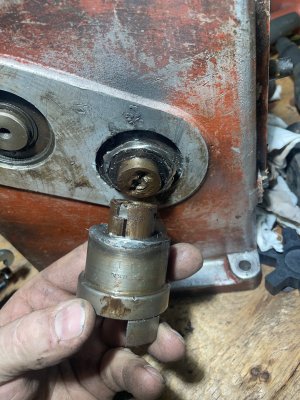Redneck_Sophistication
Super User
Robinhood I’d like to start today by saying
Me dumb you smart.
Thank you for coming to my TED talk.
Ok I never said I knew what I was doing, but I do an ok impression of it lol.
I’m more of a melt metal, power of the gods! fuse steel together mostly straight and/or square kind of metalworker. But I AM trying to be more refined
I went in the shop and was laying out bolt holes and space underneath, pics of the gear shifters etc.
Oh yeah the gear box that just “came with all the stuff” that I haven’t looked at in months.
Yeah it’s from the lathe. Ugh.
Could bolt right in. This is mind boggling to me. WHY would you want a dinky gear box then dual sized pulleys before your big massive gearbox built in the lathe?!
It’s got two different pulley sizes. Not sure how the heck you change the belt on it. Guessing there was a step pulley on the lathe at some point.
Gear box seems to have two speeds, but not sure the shape of them. What looks like it was a shift fork is missing, there’s a spring there, gently tried to move the gear and it didn’t want to move. I’m leaving that alone before I break it. The ratio is 1:1 1/8
It looks like the gear sets were welded to the shaft at some point also the coupler.
Started this post before I had to run out for a couple appointments and the belt tensioning was bugging me and I remembered as I was driving something in the box of junk I got with and there was a block with some sort of idler pulley on it.
This is finally starting to make sense!




Me dumb you smart.
Thank you for coming to my TED talk.
Ok I never said I knew what I was doing, but I do an ok impression of it lol.
I’m more of a melt metal, power of the gods! fuse steel together mostly straight and/or square kind of metalworker. But I AM trying to be more refined
I went in the shop and was laying out bolt holes and space underneath, pics of the gear shifters etc.
Oh yeah the gear box that just “came with all the stuff” that I haven’t looked at in months.
Yeah it’s from the lathe. Ugh.
Could bolt right in. This is mind boggling to me. WHY would you want a dinky gear box then dual sized pulleys before your big massive gearbox built in the lathe?!
It’s got two different pulley sizes. Not sure how the heck you change the belt on it. Guessing there was a step pulley on the lathe at some point.
Gear box seems to have two speeds, but not sure the shape of them. What looks like it was a shift fork is missing, there’s a spring there, gently tried to move the gear and it didn’t want to move. I’m leaving that alone before I break it. The ratio is 1:1 1/8
It looks like the gear sets were welded to the shaft at some point also the coupler.
Started this post before I had to run out for a couple appointments and the belt tensioning was bugging me and I remembered as I was driving something in the box of junk I got with and there was a block with some sort of idler pulley on it.
This is finally starting to make sense!

